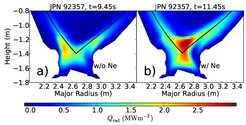Characterisation of Highly Radiating Plasmas with Neon
In future fusion devices a large fraction of the power has to be dissipated by electromagnetic radiation before it damages the divertor targets. The puffing of impurities like neon into the plasma increases the radiation, but also might impact the plasma's stability.

In experiments at the Joint European Torus (JET) in Culham (GB) it was shown that the radiation mainly came from the outer core plasma and from a region around the so-called X-point. The additional radiation had only marginal impact on the energy confinement. At highest neon puff rates and highest heating powers (29 MW) a stable regime with high confinement was reached, without the characteristic oscillations that are typically found in high confinement regimes (ELMs). At lower heating powers and neon puff rates instead, transitions to the low confinement regime were observed.
In this stable high confinement regime only few power reached the divertor targets, a state which is called complete detachment. The density at the outer core plasma was decreased by the high neon puffing. It was observed that this decrease in density, the detachment, the radiation at the X-point, and reaching the stable high confinement regime occurred simultaneously. The reason of this behaviour is currently being investigated by numerical simulations. A regime as the one found in these experiments would be highly desirable for future fusion reactors.
The work is published in Nuclear Fusion: https://doi.org/10.1088/1741-4326/ab3f7a
